I Didnt Turn on Audit but Cant Upload Templates
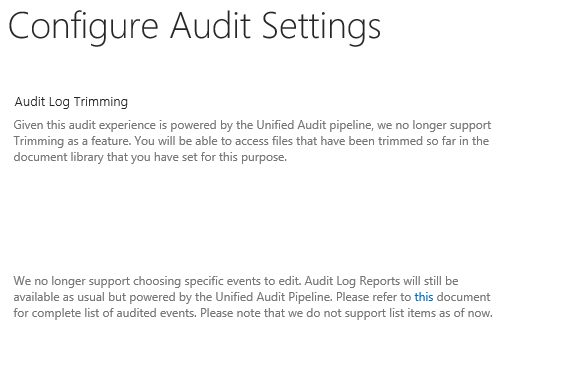
Changes to SharePoint audit settings
Microsoft 365 Unified Audit Logging now supports SharePoint and OneDrive. Unified auditing provides access to issue logs (like view, create, edit, upload, download, and delete) and sharing deportment like invitation and access requests, and synchronization activeness. For more information about what Unified Audit Logging in Microsoft 365 provides for SharePoint, see Audited activities.
Summary of Inspect Log Report changes:
-
Trimming inspect log reports is no longer a characteristic but you tin still access files that have been trimmed in the by in the document library that you have ready for this purpose.
-
Audit Log Reports volition no longer allow for specific events to exist edited. Audit Log Reports will nevertheless be available but will be limited to specific types of events.
-
For Customize Reports, the location pick has been subconscious because reports scoped at the sub-site level are no longer supported.
Run Audit Log Reports in SharePoint:
-
Select Settings > Site settings. If y'all don't run across Site settings, selectSite data then selectView all site settings. Some pages might require you to select Site contents, and then Site settings.
-
If you are non at the root of your site drove, under Site Drove Assistants, select Go to top level site settings.
Notes:
-
The Site Collection Administration department won't be available if you don't have the necessary permissions. You demand to be a fellow member of the default Site Collections Administrators group or a farm administrator.
-
If the Audit log Reports link is not available under Site Settings, brand sure you accept the Site Drove Feature "Reporting" activated.
-
-
On the Site Settings page, under Site Collection Administration, select Audit log reports.
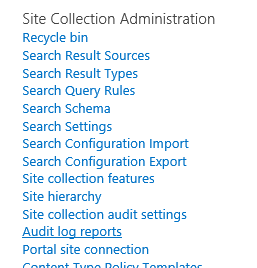
SharePoint Server 2019
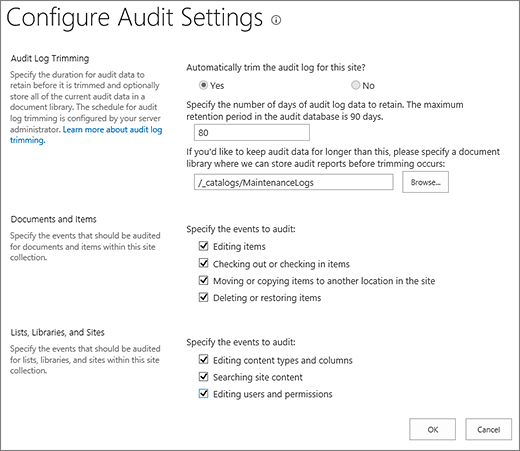
SharePoint Servers 2016 and 2013
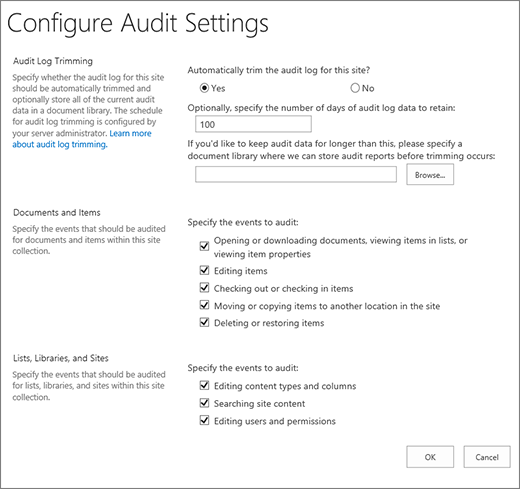
As a site collection owner, you can retrieve the history of actions taken by a item user and actions taken during a particular date range. For instance, you tin determine when a specific document was edited and by which user.
Yous can manage the size of the audit log in the Inspect Log Trimming section and specify which events to audit in the Documents and Items and Lists, Libraries, and Sites sections. You can likewise specify the maximum number of days that items will be retained. By default all items are removed at the end of the calendar month.
Note:When multiple users are co-editing a document, auditing events from multiple authors or editors can be difficult to translate. If this is a concern, consider limiting editing permission to a minimum number of users.
-
Click settings
 , and and so click Site settings. If you don't see Site settings, click Site information and so click View all site settings. Some pages might require you to select Site contents, and and so Site settings.
, and and so click Site settings. If you don't see Site settings, click Site information and so click View all site settings. Some pages might require you to select Site contents, and and so Site settings. -
If you are not at the root of your site drove, nether Site Collection Assistants, select Become to top level site settings.
Notation:The Site Collection Administration section will not exist available if you exercise not have the necessary permissions.
-
On the Site Settings page, nether Site Drove Administration, select Site collection audit settings.
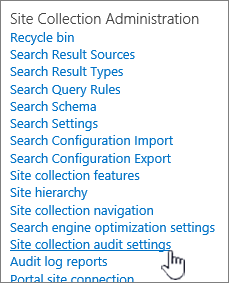
-
On the Configure Audit Settings page, in the Audit Log Trimming department, set Automatically trim the audit log for this site? to Yep.
Notes:For SharePoint
-
Trimming is not supported for SharePoint.
-
We no longer back up choosing specific events to edit. Please refer to this certificate for complete listing of audited events.
-
-
Optionally, specify the number of days of inspect log data to retain. SharePoint Server doesn't have a limit.
Note:The default setting for retaining audit log information is zero days. That means if y'all don't specify a dissimilar retention period, all inspect log entries are deleted at the end of the month. Y'all tin can change this setting to retain audit log entries for a longer menstruum of time. For example if you specify xxx days, and so audit log information that was created in the month of September wouldn't be deleted until the stop of Oct. To retain inspect log information, y'all can also salvage information technology to an audit log report before the audit log is trimmed.
-
You can also specify the document library to salve audit log reports to before the audit log is trimmed. Ready this option if you lot need access to audit log information, using audit log reports, later on the inspect log has been trimmed.
-
Select OK.
-
Select Settings > Site settings. If you don't come across Site settings, selectSite information then selectView all site settings. Some pages might require you to select Site contents, and and then Site settings.
-
If you are not at the root of your site drove, under Site Drove Administration, select Get to top level site settings.
Note:The Site Collection Administration section won't be available if you don't take the necessary permissions. You demand to be a fellow member of the default Site Collections Administrators grouping or a farm ambassador.
-
On the Site Settings page, under Site Collection Administration, select Site collection audit settings.

-
On the Configure Inspect Settings folio, in the Documents and Items and Listing, Libraries, and Site sections, select the events you want to audit, and and so select OK.
Which events you audit depends on your auditing needs. For case, regulatory compliance usually has specific requirements that will dictate which events yous need to audit. We recommend that you lot only audit the events required to come across your needs. Additional, unnecessary auditing tin affect the operation and other aspects of your site collection(s).
Notation:For SharePoint Server 2013, we recommend that yous simply select the Opening or downloading documents, viewing items in lists, or viewing particular properties result when absolutely necessary. This option is likely to generate a large number of events that volition potentially degrade the performance and other aspects of your site collection(s).
Audited events are captured in inspect reports that are based on Microsoft Excel 2013 and are available from the Auditing Reports page. Y'all can also create a custom report that includes a number of these events over a specified date range, within a specific area of the site drove, or filtered to an individual user. You cannot modify events one time they are logged, but site drove administrators can delete items from the inspect log and configure automatic trimming of the audit log data.
The audit log captures the following information for the events that are selected to be audited:
-
Site from which an upshot originated
-
Particular ID, type, name, and location
-
User ID associated with the event
-
Result type, date, time, and source
-
Action taken on the item
Following is an example of the data in a Deletion audit log written report. With this report, you tin decide who deleted and restored information across the site collection. You tin can use the features of Excel to filter, sort, and analyze the data.
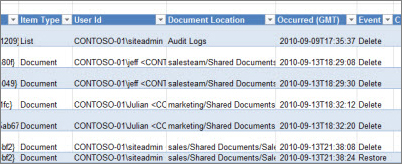
When you select an event to inspect for a site collection, the report will audit every detail in the site collection each time the result occurs. Auditing can potentially generate a big number of audit events, creating a large inspect log that could fill the hard bulldoze, impacting performance and other aspects of a site collection.
Important:To prevent the inspect log from filling the hard bulldoze and potentially degrading the performance of the site collection, we recommended that you enable inspect log trimming for site collections with extensive auditing.
To manage the size of the audit log written report yous tin can configure it to automatically trim, and optionally archive, the electric current audit log data in a document library before the data is trimmed. The schedule for audit log trimming is configured by your server administrator in Cardinal Administration. The default is the finish of the month.
To view an audit log report:
-
Click Settings
 , and and so click Site settings. If you don't run into Site settings, click Site information and so click View all site settings. Some pages might crave you to select Site contents, and then Site settings.
, and and so click Site settings. If you don't run into Site settings, click Site information and so click View all site settings. Some pages might crave you to select Site contents, and then Site settings.Annotation:The Site Collection Assistants section won't be bachelor if you don't have the necessary permissions. You demand to be a member of the default Site Collections Administrators group or a farm ambassador.
-
Click Audit log reports in the Site Collection Assistants section.
-
Select the report that you lot want on the View Auditing Reports page.
-
Type a URL or Browse to the library where you want to salve the written report, and so selectOK.
-
On the Operation Completed Successfully page, selectclick here to view this report. If you become an error, information technology may be because audit logs weren't enabled or there was no data to show.
Notes:
-
At a minimum, Excel version 2013 must exist installed to view audit log reports by clicking Click here to view this report.
-
Alternatively, if opening documents in the browser is enabled for the library, become to the library where y'all saved the audit log written report, point to the audit log report, select the down arrow, and so selectView in Browser.
-
You tin use standard Excel features to narrow the reports to the information yous desire. Some means in which you can analyze and view the log information include:
-
Filtering the audit log written report for a specific site.
-
Filtering the audit log study for a particular date range.
-
Sorting the audit log report.
-
Determining who has updated content.
-
Determining which content has been deleted but not restored.
-
Viewing the changes to permissions on an detail.
Source: https://support.microsoft.com/en-us/office/configure-audit-data-for-a-site-collection-a9920c97-38c0-44f2-8bcb-4cf1e2ae22d2
0 Response to "I Didnt Turn on Audit but Cant Upload Templates"
Post a Comment